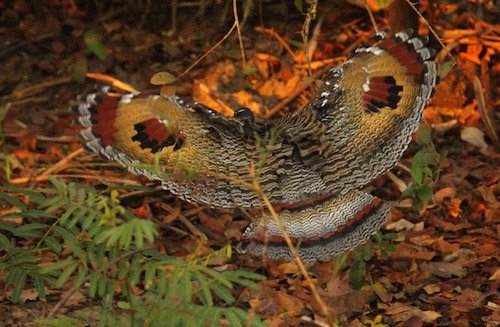Eurypygidae – Sunbittern

The sunbittern is a bittern-like bird of tropical regions of the Americas, and the sole member of the family Eurypygidae (sometimes spelled Eurypigidae) and genus Eurypyga. It ranges from Guatemala to southern Peru, showing three extant subspecies.
Male and female adult sunbitterns have can be differentiated by small differences in the feather patterns of the throat and head. Like some other birds, the sunbittern has powder down.
The sunbittern’s range extends from Guatemala to Brazil, in the humid Neotropical forests, generally with and open under-storey and near rivers and streams. The species may also be present in southern Mexico as it has been traditionally reported from the Atlantic slope of Chiapas. However, no specimens are known, nor are there any recent records of sightings.
The sunbittern is not migratory and is usually found foraging on the ground scratching for insects. They are normally cryptic but display their large wings exhibiting a pattern that resemble eyes, when they feel threatened. They start nesting in the early wet season and before it starts they make flight displays of 10m to 15m high in the forest canopy. They build open nests in trees laying two eggs with have blotched markings. The young are precocial, but remain in the nest for several weeks after hatching.
Sun Bittern aren’t just great birds in their own right, they are also of great taxonomic and bio-geographical interest. Sunbittern is the single member of its family, the Eurypigidae It’s only rather distant living relative appears to be the Kagu of New Caledonia, the sole member of the family Rhynochetidae. These two families used to be included in a heterogenous collection of birds in the Crane order (Gruiformes), but recent DNA studies (Hackett et al 2008) have led to their elevation to their own two-species order the Eurypigiformes. This makes them very distinguished – the other 39 or so orders of birds contain about 10,000 species.
The traditional bio-geographical explanation for this is that both species had a Gondwana ancestor that existed on New Caledonia when it separated from Gondwana 80 million years ago. Recent studies (see Grandcolas et al 2008) indicate that New Caledonia has probably been completely submerged since then and all terrestrial plants and animals have colonised it in the past 37 million years. If this is correct, then either the simple Sun Bittern – Kagu relationship is incorrect or their ancestors found some other way to get to where they are now, such as island hopping with extinctions obliterating their tracks. The mystery remains…
The one species is:
Sunbittern Eurypyga helias
There were formerly two species (E. helias and E. major), but now E. helias is divided into three subspecies differentiated by plumage characters and size. The three subspecies are apparently allopatry:
E. h. helias. East of the Andes in lowland tropical South America, from the Orinoco basin, through the Amazonia.
E. h. major. Found at various altitudes ranging from southern Guatemala to Ecuador.
E. h. meridionalis. Found in southern central Peru, in the lower subtropical zone (800 – 1830m).
-
Sunbittern Eurypyga helias
Species AccountSound archive and distribution map. -
Sunbittern Eurypyga helias
BirdLife Species AccountBirdLife species status and account...
-
Number of bird species: 1
